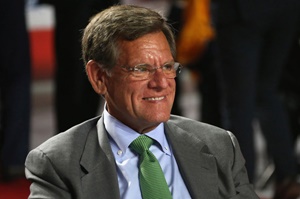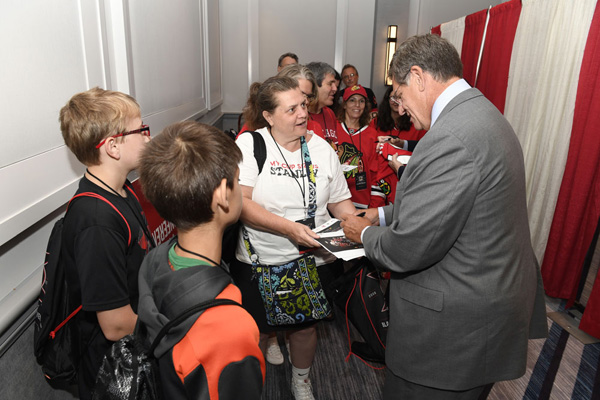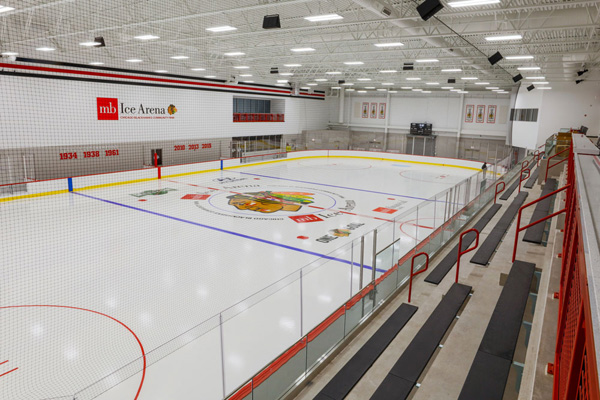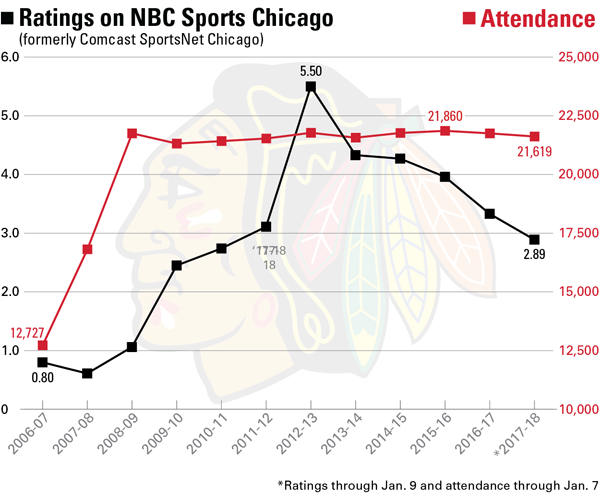 |
| Photo by: GETTY IMAGES |
Just as then-Chicago Blackhawks general manager Dale Tallon began to speak, the boos began.
It had been only days since Blackhawks owner Bill Wirtz had passed away in September 2007 at 77, and the team planned to honor him before an October home game at the United Center with a eulogy given by Tallon.
Tallon began with words that spoke to Bill Wirtz’s passion and love of Chicago, its people and the Blackhawks. But the Chicagoans grew restless, especially those who notoriously nicknamed the late owner “Dollar Bill” and detested many of his business decisions.
“As Dale started talking and Dad’s picture came up, the boos got louder and louder and louder,” recalled Bill’s son, Rocky, who took over as owner of the Blackhawks following his father’s death.
“The boos were deafening,” he added. “For a long period of time, the words ‘Wirtz,’ it was like Pavlov’s dogs — the fans just booed.”
How times have changed. In his 11th year of ownership, Rocky Wirtz is viewed as one of the model owners in any sport, while the Blackhawks have done a complete 180, transforming from what ESPN called professional sports’ worst team in 2004 to one of the NHL’s leading franchises.
That turnaround can be no clearer than the reaction of fans who spot Wirtz walking in the concourse to grab a pregame sandwich. They swamp him, take pictures, ask for autographs or just shake his hand to say thank you.
“I can’t go 20 feet out there, it gets crazy,” Wirtz said with a laugh.
The Blackhawks were veering down a bad path prior to 2007, losing more than $30 million that year and more than a combined $191 million in the 10 years prior. Wirtz said the financial troubles were so damning upon his initial dive into the books that he was concerned the franchise might cause irreparable harm to the family’s other businesses, which includes a wine and liquor distribution empire. The team needed a cash infusion of $34 million to meet payroll at the start of the 2007-08 season.
 |
Rocky Wirtz mended the team’s relationships with fans, who now seek him out for autographs and photos.
Photo by: CHICAGO BLACKHAWKS |
“It was a little like falling out a first-floor window — we couldn’t go down any further,” Wirtz said.
But Wirtz immediately developed a vision and was driven to be decisive. He focused on making the right hires, mending relationships in the community and with the fans, and implementing a number of changes that went directly against the way his father operated the team.
“One of the biggest flaws an executive can have is to not make decisions — the most important decision was to simply make a decision,” he said. “It sounds funny, but if you don’t make a decision you don’t have to worry about being wrong.”
NHL Commissioner Gary Bettman recalls meeting Rocky for dinner at Coco Pazzo in Chicago just weeks after his father had died and he had taken over the team. Only having known Rocky casually, the two spent more than six hours getting to know each other.
“Rocky was immediately focused on what he could do to reconnect the Blackhawks to that amazing Chicago sports scene, and do everything to encourage people to come back to a historic franchise,” Bettman said. “Looking back, it’s been a remarkable but not a surprising turnaround for the Blackhawks, and while the team lost its way for a while, Rocky lit the fuse to bring it right back.”
‘Pride is Back’
John McDonough has a framed photo on the wall in his United Center office that faces downtown Chicago. It shows a fan at a game in 2008 holding what appears to be a bedsheet with three words written on it: Pride is Back.
McDonough, a Chicago native and longtime Blackhawks observer, witnessed the team’s decline first hand while serving as a Cubs executive for more than 24 years, including most recently as president.
The ’Hawks Inner Circle
Rocky Wirtz, chairman and owner
The third-generation owner has overseen all aspects of the team’s operations since October 2007.
John McDonough, CEO and president
The former Chicago Cubs executive joined the Blackhawks in 2007 and has been crucial to every major initiative the team has had since.
Jay Blunk, executive vice president
A close confidant of McDonough, Blunk oversees the team’s business operations and has championed efforts on fan engagement and accessibility.
Stan Bowman, senior vice president
and general manager
The son of legendary NHL coach Scotty Bowman — a senior adviser of hockey operations for the Blackhawks — Bowman was named GM in 2009, after spending eight years in the team’s hockey operations department.
Joel Quenneville, head coach
Quenneville has led the team to three Stanley Cup championships. He is a regular participant in the team’s business meetings, serving as a crucial conduit of the team’s marketing and communication efforts.
— Ian Thomas
The two had never met before they sat down at the sports bar Champps in the Chicago suburb of Schaumburg. What was originally planned as a discussion of the Chicago sports market turned into a five-hour discussion about life, business and their families. It culminated with Wirtz pitching McDonough the idea of coming on as Blackhawks president, refusing to let him leave without an answer. McDonough had a dream job, but strongly believed that if anyone could oversee a turnaround of the Blackhawks, it would be Wirtz.
He agreed before he left the restaurant.
McDonough went to work on completely overhauling the culture and operations of the Blackhawks. “Bring me great, bring me hungry, and bring me humble,” was the directive he gave to Marie Sutera, who heads the team’s human resources department.
Jay Blunk, who had worked closely with McDonough for 22 years at the Cubs, was one of the first to join him as vice president of business operations.
“At the time, the Blackhawks didn’t even blip on the regional radar in an incredibly competitive marketplace, and very early on we realized we had to have an underdog mentality,” said Blunk, now an executive vice president with the team. “We were going to have to do things that other people don’t do — we’re going to have to over-deliver, we’re going to have to make our players the most accessible players in Chicago, and we’re going to have to show up at every charitable event.”
Leaning on their expertise in marketing and broadcasting, some of their first moves came in those areas, adding features like a fan convention akin to the one McDonough created for the Cubs, and working to mend relationships with past stars the franchise had isolated, such as Bobby Hull and Stan Mikita — players McDonough grew up watching.
Perhaps most importantly, McDonough and Blunk leveraged their connections to get the team’s games on television, a move that Bill Wirtz had opposed due to his belief that it would hurt ticket sales.
“I was coming from a franchise where our games would go into 80 million homes 162 times a year and people coast to coast knew who the 25th guy on our roster was. Our games were not on television,” said McDonough. “But the day that Rocky took over and started to go in a completely different direction than his father, I think it got everyone’s attention, and a vibration was felt that something different was happening.”
The Blackhawks even went as far as becoming a corporate sponsor of both the Cubs and the White Sox, with scoreboard features showing up at every game — “We had to fish where the fish are,” Blunk said.
Borrowing a page from the Wirtz business empire, the Blackhawks installed a corporate culture that broke down the walls between the business and personnel sides — a rarity in sports. Under this structure, Blackhawks Coach Joel Quenneville or GM Stan Bowman would accompany McDonough and Blunk to a meeting with a sponsor, while the opposite may occur during a scouting meeting. Staff meetings include every member of the organization, regardless of the topic.
 |
John McDonough tours the team’s new training center.
Photo by: CHICAGO BLACKHAWKS |
Thanks in large part to an on-ice renaissance led by young players like Patrick Kane and Jonathan Toews, the Blackhawks quickly started to gain traction. For the 2008-09 season, the team surpassed its previous record of 13,425 season-ticket holders, shattering its single-season attendance record that same season. It also played in the Winter Classic that year at Wrigley Field, dramatically raising the team’s profile both locally and nationally.
It was later in that season when McDonough spotted that fan unfurling the “Pride is Back” banner in the upper sections of the United Center. The team’s three Stanley Cup wins aside, it’s a moment that McDonough said is the highlight of the last 10 years; a message symbolic of the complete overhaul the franchise has undergone.
“I remember speaking with Rocky and saying that I hope this fan base is feeling what I’m feeling because I feel this thing is coming on strong,” he said. When McDonough spotted that banner, “that’s when I got a sense that they knew something was coming too.”
He approached the fan and asked if he could have the banner, to which the fan responded that if the message meant that much to him, sure. McDonough told him, “You have no idea.” He keeps the banner folded in a drawer in his office.
The next 10 years
These last 10 years have been some of the most fruitful in sports for the Blackhawks. Overall revenue is up an astounding 342 percent from 2007 to 2017. Ticket revenue is up 520 percent; concession and retail revenue is up 635 percent; and sponsorship revenue is up 503 percent. While the bar was set low, few sports organizations can report such significant returns. The team’s season-ticket renewal rate is nearly 99 percent, one of the best in the NHL, and regular-season television ratings are up 490 percent in that 10-year period.
Now, the Blackhawks are plotting out the next 10 years and looking to remain innovative in their business practices, a mantra that McDonough has aimed to instill in all employees.
“They say after 10 years that maybe some of the motivation wears off a bit. I don’t see it,” he said. “We’re still the underdog, and we have a chip on our shoulder every single day. I don’t want us to get caught napping saying, ‘well, the Blackhawks are the new gold standard,’ because I am a firm believer that once you stop to admire what you’ve done, you’ve stopped and it’s hard to get started again.”
 |
Seating areas allow fans to watch Blackhawks practices, which are now open to the public.
Photo by: CHICAGO BLACKHAWKS |
McDonough said that neither he nor Wirtz or anyone in the organization is satisfied — despite the three Stanley Cups, five Western Conference finals, leading the league in attendance for nine years, and new office and practice facilities.
“I feel the engine is just getting started,” he said. “The emphasis is on innovation and trying things that are distilled and well thought out, but just haven’t been done before, and it’s that opportunity that we’re going for.”
Some of that was on display at the team’s training camp and annual scrimmage this season, where more than 20,000 fans attended. The Blackhawks flew drones over the ice to create new camera angles and captured audio from players on the ice and the bench.
Blunk pointed to that crossover between the business side and hockey side of the team, which allows for deeper access to the players and ultimately more content for digital and social media, a continued focus for the team.
Charlie Besser, president and CEO of Intersport and a longtime Chicago resident, noted the Blackhawks’ commitment to elevating its product.
A place to skate
The Chicago Blackhawks’ drive to deepen their ties to the community was demonstrated in November when the team opened its new $65 million, 125,000-square-foot training center roughly two blocks south of the United Center.
Originally envisioned as a one-ice-sheet facility solely for the Blackhawks, team owner Rocky Wirtz instead decided to up the ante and add a second rink, 22 locker rooms to house local teams, a separate training and workout facility, space to host schools and classes, and a full-service bar and food stand run by Levy, who also operates the United Center concessions. There’s also standing room and seating areas for fans to watch Blackhawks practices, which are now open to the public.
“One sheet would have been much cheaper and we could have done it on United Center land, but to be able to build something to give back to the community and provide access to people so that they can relate to this team no matter if they can afford to buy a ticket or not is important,” said Wirtz, who financed the project.
Wirtz said he is now looking into ways to further develop the United Center campus and its neighborhood, known as Near West Side, into a “year-round destination.” Last year, a 190,000-square-foot addition to the United Center opened. The HOK-designed space provides new offices for both the Blackhawks and Bulls, a new box office, a team store and a five-story central atrium, that includes a sky lounge and bar.
— Ian Thomas
“At a time when experiences matter more than anything, the Blackhawks consistently deliver the highest-rated sports fan experience in Chicago and one of the best in the nation,” he said. “Plus, until the Cubs emerged, they raised the collective championship spirit of our great city.”
The team will look to build on its local and regional fan base as it plays in its NHL-leading sixth outdoor game next Jan. 1 at Notre Dame.
“When you connect to Notre Dame and Notre Dame football and that campus, it can take your brand to places it’s never been before — when we’re trying to mainstream the Blackhawks brand, there’s nothing better,” Blunk said. “There’s still enormous growth potential with this franchise, and from my vantage point, I think we have more opportunity in front of us now than ever because we are now a mainstream brand in Chicago.”
For Wirtz, the team’s continued success comes down to something that he’s heavily focused on these last 10 years.
“It’s reinforced for me how important, especially in Chicago, relationships are. Relationships with players, your employees, your fans, even the media,” he said. “For whatever reason, we didn’t have very good relationships then, and if we did, we let them go by the wayside.”
As Wirtz watches each game, he’s now used to fans coming over to his seat and asking to shake his hand. “When people come around and say thank you, I don’t think it’s just for the championships. I think it’s being relevant to them again, and being important in their lives.”
He paused before adding, “As they know there’s nothing you won’t do to try to win, they’ll support us.”
At the start of a game on Jan. 7, another sold-out crowd finished singing “The Star-Spangled Banner” in unison. Wirtz took it all in and said with a smile: “I still am surprised by not being booed.”







